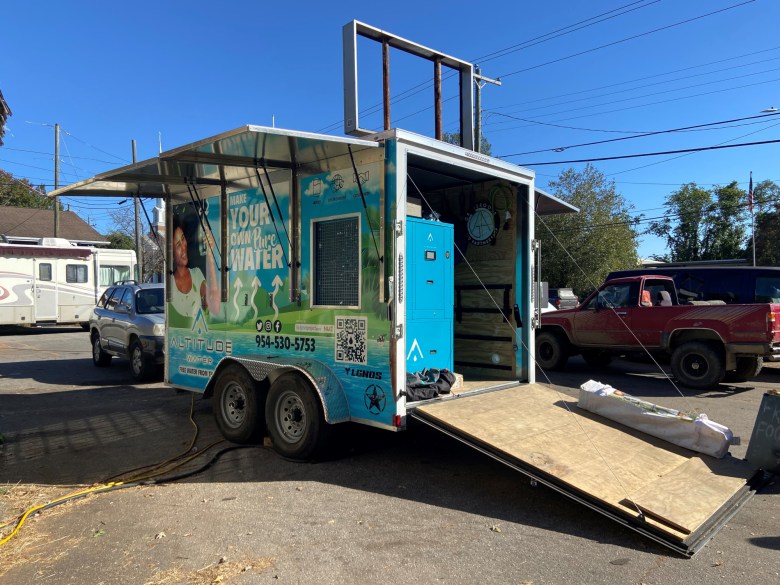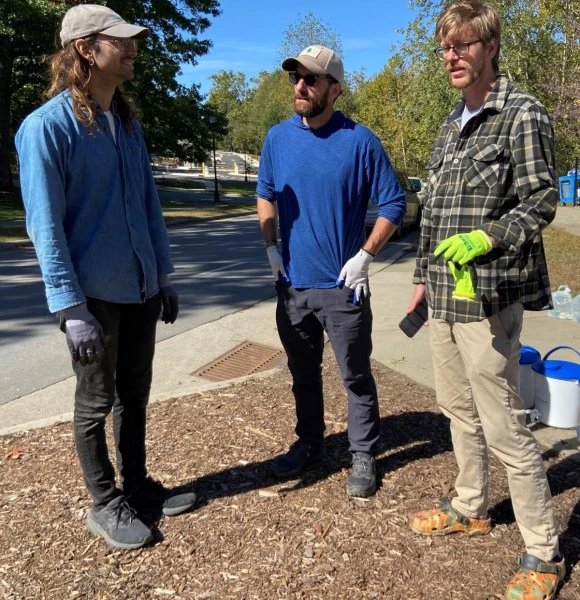This story was originally published by Energy News Network.
Seventeen days after Hurricane Helene devastated Western North Carolina, tearing down power lines, destroying water mains and disabling cell phone towers, the signs of relief were hard to miss.
Trucks formed a caravan along Interstate 40, filled with camouflaged soldiers, large square tanks of water and essentials from pet food to diapers. In towns, roadside signs — official versions emblazoned with nonprofit relief logos and wooden makeshift ones scrawled with paint — advertised free food and water.
And then there were the generators.
The noisy machines powered the trailers where Asheville residents sought showers, weeks after the city’s water system failed. They fueled the food trucks delivering hot meals to the thousands without working stoves. They filtered water for communities to drink and flush toilets.
Western North Carolina is far from unique. In the wake of disaster, generators are a staple of relief efforts around the globe. But across the region, a New Orleans-based nonprofit is working to displace as many of these fossil fuel burners as they can, swapping in batteries charged with solar panels instead.
It’s the largest response effort the Footprint Project has ever deployed in its short life, and organizers hope the impact will extend far into the future.
“If we can get this sustainable tech in fast, then when the real rebuild happens, there’s a whole new conversation that wouldn’t have happened if we were just doing the same thing that we did every time,” said Will Heegaard, operations director for the organization.
“Responders use what they know works, and our job is to get them stuff that works better than single-use fossil fuels do,” he said. “And then, they can start asking for that. It trickles up to a systems change.”
A ‘no-brainer’ solution to the problem of gas generators
The rationale for diesel and gas generators is simple: They’re widely available. They’re relatively easy to operate. Assuming fuel is available, they can run 24-7, keeping people warm, fed and connected to their loved ones even when the electric grid is down. Indubitably, they save lives.
But they’re not without downsides. The burning of fossil fuels causes not just more just more carbon that exacerbates the climate crisis, but smog and soot-forming air pollutants that can trigger asthma attacks and other respiratory problems.
In Puerto Rico after Hurricane Maria, generators were so prevalent after the electric grid failed that harmful air pollution in San Juan soared above the safe legal limit. The risk is especially acute for sensitive populations who turn to generators for powering vital equipment like oxygenators.
Crushed by negative news?
Sign up for the Reasons to be Cheerful newsletter.
There are also practical challenges. Generators aren’t cheap, retailing at big box stores for more than $1,000. Once initial fuel supplies run out — as happened in parts of Western North Carolina in the immediate aftermath of Helene — it can be difficult and costly to find more. And the machines are noisy, potentially harming health and creating more stress for aid workers and the people they serve.
Heegaard witnessed these challenges firsthand in Guinea in 2016 when he was responding to an Ebola outbreak. A paramedic, his job was to train locals to collect blood samples and store them in generator-powered refrigerators that would be motorcycled to the city of Conakry for testing. He had a grant to give cash reimbursements to the lab techs for the fuel.
“This is so hard already, and the idea of doing a cash reimbursement in a super poor rural country for gas generators seems really hard,” Heegaard recalled thinking. “I had heard of solar refrigerators. I asked the local logistician in Conakry, ‘Are these things even possible?’”
The next day, the logistician said they were. They could be installed within a month. “It was just a no-brainer,” said Heegaard. “The only reason we hadn’t done it is the grant wasn’t written that way.”
‘Game changing for a response’
Two years later, the Footprint Project was born of that experience. With just seven full-time staff, the group cycles in workers in the wake of disaster, partnering up with local solar companies, nonprofits and others, to gather supplies and distribute as many as they can.
They deploy solar-powered charging stations, water filtration systems, and other so-called climate tech to communities who need it most — starting with those without power, water or a generator at all, and extending to those looking to offset their fossil fuel combustion.

The group has now built nearly 50 such solar-powered microgrids in the region, from Lake Junaluska to Linville Falls, more than it has ever supplied in the wake of disaster. The recipients range from volunteer fire stations to trailer parks to an art collective in West Asheville.
Mike Talyad, a photographer who last year launched the collective to support artists of color, teamed up with the Grassroots Aid Partnership, a national nonprofit, to fill in relief gaps in the wake of Helene. “The whole city was trying to figure it out,” he said.
Solar panels from Footprint that initially powered a water filter have now largely displaced the generators for the team’s food trucks, which last week were providing 1,000 meals a day. “When we did the switchover,” Talyad said, “it was a time when gas was still questionable.”
The team at Footprint also recently provided six solar panels, a Tesla battery and charging station to displace a noisy generator at a retirement community in South Asheville.
The device was powering a system that sucked water from a pond, filtered it, and rendered it potable. Picking up their jugs of drinking water, a steady flow of residents oohed and aahed as the solar panels were installed, and sighed in relief when the din of the generator abated.
“Most responders are not playing with solar microgrids because they’re better for the environment,” said Heegaard. “They’re playing with it because if they can turn their generator off for 12 hours a day, that means literally half the fuel savings. Some of them are spending tens of thousands of dollars a month on diesel or gas. That is game changing for a response.”
‘Showing up for their neighbors’
Footprint’s robust relief effort and the variety of its beneficiaries is owed in part to the scale of Helene’s destruction, with more than one million in North Carolina alone who initially lost power.
“It’s really hard to put into words what’s happening out there right now,” said Matt Abele, the executive director of the North Carolina Sustainable Energy Association, who visited in the early days after the storm. “It is just the most heartbreaking thing I’ve ever seen — whole mobile home parks that are just completely gone.”
But the breadth of the response is also owed to Footprint’s approach to aid, which is rooted in connections to grassroots groups, government organizations and the local solar industry. All have partnered together for the relief effort.
“We’ve been incredibly overwhelmed by the positive response that we’ve seen from the clean energy community,” Abele said, “both from an equipment donation standpoint and a financial resources standpoint.”

Some four hours east of the devastation in Western North Carolina, Greentech Renewables Raleigh has been soliciting and storing solar panels and other goods. It’s also raising money for products that are harder to get for free — like PV wire and batteries. Then it trucks the supplies west.
“We’ve got bodies, we’ve got trucks, we’ve got relationships,” said Shasten Jolley, the manager at the company, which warehouses and sells supplies to a variety of installers. “So, we try to utilize all those things to help out.”
The cargo is delivered to Mars Hill, a tiny college town about 20 miles north of Asheville that was virtually untouched by Helene. Through a local regional government organization, Frank Johnson, the owner of a robotics company, volunteered his 110,000-square-foot facility for storage.
Johnson is just one example of how people in the region have leapt to help each other, said Abele, who’s based in Raleigh.
“You can tell when you’re out there,” he said, “that so many people in the community are coping by showing up for their neighbors.”
‘Available for the next response’
To be sure, Footprint’s operations aren’t seamless at every turn. For instance, most of the donated solar panels designated for the South Asheville retirement community didn’t work, a fact the installers learned once they’d made the 40-minute drive in the morning and tried to connect them to the system. They returned later that afternoon with functioning units, but then faced the challenge of what to do with the broken ones.
“This is solar aid waste,” Heegaard said. “The last site we did yesterday had the same problem. Now we have to figure out how to recycle them.”
It’s also not uncommon for the microgrids to stop working, Heegaard said, because of understandable operator errors, like running them all night to provide heat.
But above all, the problem for Footprint is scale. A tiny organization among behemoth relief groups, they simply don’t have the bandwidth for a larger response. When Milton followed immediately on the heels of Helene, Heegaard’s group made the difficult choice to hunker down in North Carolina.
With climate-fueled weather disasters poised to increase, the organization hopes to entice the biggest, most well-resourced players in disaster relief to start regularly using solar microgrids in their efforts.
As power is slowly restored across the region, with just over 5,000 remaining without electricity, there’s also the question of what comes next.
While there’s a parallel conversation underway among advocates and policymakers about making microgrids and distributed solar a more permanent feature of the grid, Footprint also hopes to inspire some of that change from the ground up. Maybe the volunteer fire station decides to put solar panels on its roof when it rebuilds, for instance.
“We can change the conversation around resilience and recovery by directly pointing to something that worked when the lights were out and debris was in the street,” Heegaard said.
As for the actual Footprint equipment, the dream is to create “lending libraries” in places like Asheville, to be cycled in and out of community events and disaster relief.
“The solar trailer or the microgrid or the water maker that went to the Burnsville elementary school right after the storm — that can be recycled and used to power the music stage or the movie in the park,” Heegaard said. “Then that equipment is here, it’s being utilized, and it’s available for the next response, whether it’s in Knoxville or Atlanta or South Carolina.”
The post Solar-Powered Generators Are Fueling Hurricane Relief in North Carolina appeared first on Reasons to be Cheerful.




